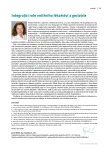Chronic non-healing wounds in geriatrics
Authors:
Vojtěch Mezera; Ivo Bureš
Authors‘ workplace:
Geriatrické centrum, Pardubická nemocnice, Nemocnice Pardubického kraje, a. s.
Published in:
Vnitř Lék 2018; 64(11): 1098-1104
Category:
Overview
Chronic non-healing wounds represent a frequent comorbidity among geriatric patients. Non-healing wounds increase patients‘ morbidity and mortality and significantly decrease their quality of life. Prognosis of these wounds depends on etiology, overall health condition of the patient and also on the proper treatment. In this review we outline the classification of non-healing wounds and focus in more detail on the most frequent types: venous and arterial leg ulcers, diabetic foot syndrome and pressure ulcers.
Key words:
diabetic foot ulcers – chronic venous insufficiency – chronic wounds – limb ischemia – non-healing wounds – pressure ulcers
Sources
- Krasner D, Rodeheaver G, Sibbald G. Chronic Wound Care. In: Krasner D, Rodeheaver G, Sibbald G (eds). A Clinical Source Book for Healthcare Professionals. 4th ed. HMP Communications: Malvern (PA) 2007.
- Mrázová R, Pokorná A, Krejcar M. Možnosti v hojení ran. Med Praxi 2012; 9(2): 83–86.
- Calne S. Hard-to-heal wounds: a holistic approach [Internet]. EWMA 2008. Dostupné z WWW: <http://ewma.conference2web.com/#resources/215693>.
- Redelings MD, Lee NE, Sorvillo F. Pressure ulcers: more lethal than we thought? Adv Skin Wound Care 2005; 18(7): 367–372.
- Alderden J, Rondinelli J, Pepper G et al. Risk factors for pressure injuries among critical care patients: A systematic review. Int J Nurs Stud 2017; 71: 97–114. Dostupné z DOI: <http://dx.doi.org/10.1016/j.ijnurstu.2017.03.012>.
- Dimri GP, Lee XH, Basile G et al. A Biomarker That Identifies Senescent Human-Cells in Culture and in Aging Skin in-Vivo. Proc Natl Acad Sci USA 1995; 9(20): 9363–9367.
- Velarde MC, Flynn JM, Day NU et al. Mitochondrial oxidative stress caused by Sod2 deficiency promotes cellular senescence and aging phenotypes in the skin. Aging (Albany NY) 2012; 4(1): 3–12. Dostupné z DOI: <http://dx.doi.org/10.18632/aging.100423>.
- Velarde MC, Demaria M, Melov S et al. Pleiotropic age-dependent effects of mitochondrial dysfunction on epidermal stem cells. Proc Natl Acad Sci 2015; 112(33): 10407–10412. Dostupné z DOI: <http://dx.doi.org/10.1073/pnas.1505675112>.
- Schultz GS, Mast BA. Molecular Analysis of the Environments of Healing and Chronic Wounds: Cytokines, Proteases and Growth Factors Molecular Regulation of Wound Healing The Roles of Cytokines and Growth Factors in Wound Healing. 1999. Dostupné z WWW: http://www.woundsaustralia.com.au/journal/0701_01.pdf
- Westby MJ, Dumville JC, Stubbs N et al. Protease-modulating matrix treatments for healing venous leg ulcers. Cochrane Database Syst Rev 2015; 2015:10.
- Arturo J. Martí-Carvajal, Gluud CH, Nicola S et al. Growth factors for treating diabetic foot ulcers. Cochrane Database Syst Rev 2015; (10): CD008548. Dostupné z DOI: <http://dx.doi.org/10.1002/14651858.CD008548.pub2>.
- Martinez-Zapata M, Martí-Carvajal A, Solà I et al. Autologous platelet-rich plasma for treating chronic wounds (Review). Cochrane Database Syst Rev 2016; (5): 1–67. CD006899. Dostupné z DOI: <http://dx.doi.org/10.1002/14651858.CD006899.pub3>.
- Piaggesi A. Advanced Therapies in Wound Management Cells and Tissue-Based Therapies. J Wound Care 2018; 27(Sup6a): S1-S137. Dostupné z DOI: <http://dx.doi.org/10.12968/jowc.2018.27.Sup6a.S1>.
- Nelson EA, Adderley U. Venous leg ulcers. BMJ Clin Evid 2016; 2016. pii: 1902.
- Pospíšilová A. Bércový vřed – Standard léčebného plánu [Internet]. 2007. Dostupné z WWW: <http://www.cslr.cz/Informace-pro-praxi/Doporucene-lecebne-postupy/>.
- [National Pressure Ulcer Advisory Panel European Pressure Ulcer Advisory Panel and Pan Pacific Pressure Injury Alliance]. Prevention and Treatment of Pressure Ulcers : Quick Reference Guide. Haesler E, editor. Clinical Practice Guideline. Cambridge Media: Perth, Australia 2014: 1–75. ISBN 978–0-9579343–6-8. Dostupné z WWW: <https://www.npuap.org/wp-content/uploads/2014/08/Updated-10–16–14-Quick-Reference-Guide-DIGITAL-NPUAP-EPUAP-PPPIA-16Oct2014.pdf>.
- Bredesen IM, Bjøro K, Gunningberg L et al. The prevalence, prevention and multilevel variance of pressure ulcers in Norwegian hospitals: A cross-sectional study. Int J Nurs Stud 2015; 52(1): 149–156. Dostupné z DOI: <http://dx.doi.org/10.1016/j.ijnurstu.2014.07.005>.
- Heinhold H, Westerfellhaus A, Kröger K. Prevalence of Pressure Ulcers in Hospitalized Patients. Sci Pract Educ 2014; 14: 9–14.
- Franks PJ, Barker J, Collier M et al. Management of Patients With Venous Leg Ulcers: Challenges and Current Best Practice. J Wound Care 2016; 25(Suppl 6): S1-S67. Dostupné z DOI: <http://dx.doi.org/10.12968/jowc.2016.25.Sup6.S1>.
- Stryja J. Specifika lokální terapie kožních defektů u pacientů s obliterující aterosklerózou DK 2006. (Doporučené léčebné postupy). Dostupné z WWW: <http://www.cslr.cz/Informace-pro-praxi/Doporucene-lecebne-postupy/>.
- Martinez-Zapata MJ, Vernooij RWM, Uriona Tuma SM et al. Phlebotonics for venous insufficiency (Review). Martinez-Zapata 2016; 4.
- Moore ZE, van Etten MT, Dumville JC. Bed rest for pressure ulcer healing in wheelchair users. Cochrane Database Syst Rev 2016;10:CD011999. Dostupné z DOI: <http://dx.doi.org/10.1002/14651858.CD011999.pub2>.
- Saha S, Totten A, Smith MEB et al. Pressure Ulcer Treatment Strategies: Comparative Effectiveness. Press Ulcer Treat Strateg Comp Eff 2013; 90: 488.
- Krupová L, Pokorná A. Systémový přístup k prevenci dekubitů. Léčba ran 2018; 5(2): 4–6.
- Kolková A, Šeflová L. Laický pečovatel a prevence dekubitů. Léčba ran 2018; 5(2)2: 14–17.
- Boulton AJ. The Diabetic Foot [Internet]. ENDOTEXT. 2016. Dostupné z WWW: http://www.endotext.org/chapter/the-diabetic-foot
- Jirkovská A, Lacigová S, Rušavý Z et al. Doporučený postup pro prevenci, diagnostiku a terapii syndromu diabetické nohy 2016. (Standardy a doporučení). Dostupné z WWW: <http://www.diab.cz/standardy>.
- Singh N, Armstrong DG, Lipsky BA. Preventing foot ulcers in patients with diabetes. JAMA 2005; 293(2): 217–228.
- Armstrong DG, Lavery LA, Harkless LB. Validation of a Diabetic Wound Classification System: The contribution of depth, infection, and ischemia to risk of amputation. Diabetes Care 1998; 21(5): 855–859.
- Kranke P, Bennett MH, Martyn-St James M et al. Hyperbaric oxygen therapy for chronic wounds (Review). Cochrane Database Syst Rev 2015 (6):CD004123.5–20. Dostupné z DOI: <http://dx.doi.org/10.1002/14651858.CD004123.pub4>.
Labels
Diabetology Endocrinology Internal medicineArticle was published in
Internal Medicine

2018 Issue 11
Most read in this issue
- Thermoregulatory disorders and their significance in the elderly
- Sarcopenia as a severe organ failure, its diagnosing and present therapeutic possibilities
- Electrolyte and water disorders in old age
- Falls: a significant cause of morbidity and mortality in elderly people
